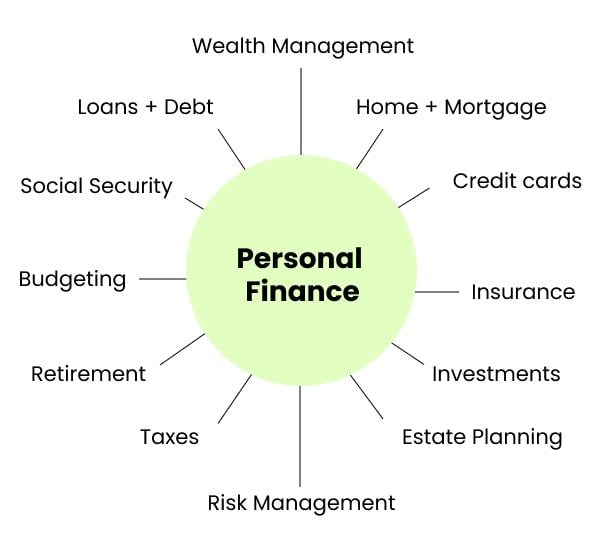Personal finance incorporates how you manage all aspects of you or your family’s finances – both short-term and long-term. The term is also used to describe an entire industry devoted to the services and products designed to help individuals manage their finances and take advantage of investment opportunities.
What is Personal Finance?
Personal finance is the process of planning and managing personal financial activities such as income generation, spending, saving, investing, and protection. The process of managing one’s personal finances can be summarized in a budget or financial plan. This guide will analyze the most common and important aspects of individual financial management.

Why Is Personal Finance Important?
Personal finance is a vital part of not only managing your day-to-day financial needs but also planning your financial future. The sooner you get a grip on personal finance, the better your long-term financial prospects will be for things like investing or planning for retirement.
By understanding the elements of personal finance, you can better understand opportunities to improve your finances. This understanding can help you budget for current needs while planning for long-term financial goals.

Defining Personal Financial Management
Essentially, personal financial management employs creative tools in creating financial models and strategies to manage how your money is spent effectively. It is a process that involves setting financial goals, budgeting, and planning how your income is allocated to meet strategic financial needs.
One of the most crucial pillars of personal financial management is budgeting. Having a budget gives you an idea of your real disposable income and can be used to manage unpaid debt if you have any effect. In essence, you can plan for the future and cater to the present using the most available assets through budgeting.
Traditional personal financial management is largely based on written calculations and paper spreadsheets. However, this old method has long given way to simpler software applications accessible on your computers and phones.
Understanding Personal Finance Planning Process

Every effective personal financial plan has a process structure adopted to help you accomplish your financial goals, whether long or short. Below, we shall be examining five crucial planning processes you can explore to improve your financial situation.
Create your Goals
You are only one step nearer to where you want to be financial if you have your financial goals expressly written down. Draw a list of goals you want to achieve in the present, which serves as an immediate short-term plan, and the long-term goals you would like to accomplish. These goals don’t have to be rigid; you can always review them periodically as your income level improves.
Evaluate your Personal Life
You can only accomplish set goals if all the financial factors operating in your life permit it. Therefore, gathering relevant data such as income and expenditure patterns in your life is important. Analyzing this data helps you define your financial priorities and reveals your financial barriers like debt and tax burdens and how long it will take for your goals to materialize.
Design Your Financial Plan
While others prefer to have professional help with this, even qualified professionals will rely heavily on the first two processes to design your financial plan. First, consider all your recurring expenditures, investments, and savings when creating a financial plan. This way, you can manage your income more effectively by sticking to the allocation percentage of your income to the items in your financial plans.
Implementation and Periodic Review
No matter how tight your financial plan is, it will remain on paper or as text in your software application if you do not implement it. Therefore, take very deliberate and consistent steps to implement and strictly adhere to your financial plan, and always leave room for periodic review of your plan. As your income or expenditure increases, it must be reflected in your plan as you must adjust it accordingly.
Personal Financial Management Applications

As mentioned earlier, organizing your financial plans no longer requires tedious paperwork. Since the advent of Intuit in 1983 by Scott Cook and Tom Proulx, personal finance software has been consistently evolving to ensure you can operate a seamless financial plan with little or no professional help. While you may find some of these apps for free, others offer paid premium services as better alternatives. Regardless, below are our top three personal financial management apps.
Quicken
For a couple of reasons, Quicken has remained the most talked-about application for personal finance management. First, although not free, they offer flexible payment plan packages that cater extensively to basic personal finance needs, investment, and business planning.
Also, Quicken offers flexible traction for your income, taxes, and investments and turns on periodic reporting on your finances and bill management. They have also integrated some elements of mobile banking as they offer bill payment services.
Mint
Designed by the originators of personal finance management apps, Intuit, Mint helps you keep track of your expenditure in one place. You can use this app on multiple devices and have your planner wherever you go.
Moreover, Mint has structured a system that helps you keep your credit in check and design a repayment plan to ensure you get out of debt fast. It also has a budget planner and an expenditure tracking system that helps you track your spending. In addition, you can sign up for free and enjoy credit score improvement schemes.
Tiller
Tiller offers you a simple approach to creating a meaningful spreadsheet. You get to see all your expenditure in a simple glance at just a single glance. You get instant spending categorization, and you can easily create a budget plan from the well-structured data this app will compute from your personal finance.
The application also offers free templates to create debt repayment plans, net worth estimations, and trend analyses of all your recurring payments. Interestingly, they offer a thirty-day trial period with a subsequent rate of $79 for a whole year.




